 W
WItalian Libya was a colony of the Kingdom of Italy located in North Africa, in what is now modern Libya, between 1934 and 1943. It was formed from the unification of the colonies of Italian Cyrenaica and Italian Tripolitania, which had been Italian possessions since 1911.
 W
WThe Ascari del Cielo were the first paratroopers of the Italian armed forces. They all were born in Libya and with Arab-Berber ethnicity. They constituted the majority of the troops of the Battalion Fanti dell Aria, created in 1938, that fought in the Desert War during World War II.
 W
WThe Babini Group was an ad hoc armoured unit. The group was formed by the Italian Royal Army in Italian North Africa (Libya) at the start of the Western Desert Campaign of the Second World War. The group was formed in Libya, to be part of an armoured division assembled from tanks in the colony and from units sent from Italy. The new division was incomplete when the British began Operation Compass in December but the Babini Group fought in defence of the area between Mechili and Derna in late January.
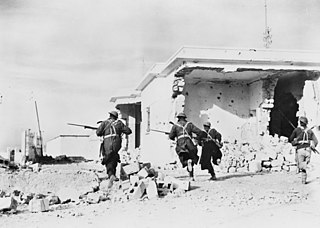 W
WThe Battle of Bardia was fought between 3 and 5 January 1941, as part of Operation Compass, the first British military operation of the Western Desert campaign of the Second World War. It was the first battle of the war in which an Australian Army formation took part, the first to be commanded by an Australian general and the first to be planned by an Australian staff. The 6th Australian Division assaulted the strongly held Italian fortress of Bardia, Libya, assisted by air support and naval gunfire and under the cover of an artillery barrage. The 16th Australian Infantry Brigade attacked at dawn from the west, where the defences were known to be weak. Sappers blew gaps in the barbed wire with Bangalore torpedoes and filled in and broke down the sides of the anti-tank ditch with picks and shovels. This allowed the infantry and 23 Matilda II tanks of the 7th Royal Tank Regiment to enter the fortress and capture all their objectives, along with 8,000 prisoners.
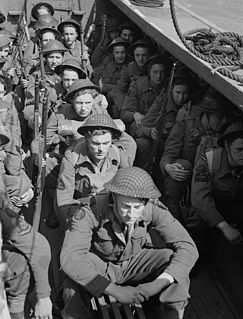 W
WThe Raid on Bardia was an amphibious landing at the coastal town of Bardia in North Africa by British Commandos over the night of 19/20 April 1941 during the Second World War. The raid was carried out by No. 7 Commando also known as A Battalion Layforce together with a small detachment from the Royal Tank Regiment supported by five navy ships and a submarine. The raid—which destroyed an Italian artillery battery and a supply dump—was deemed a success despite the loss of 71 men. The more lasting strategic effect of the raid was the diversion of a German armoured brigade from the front line to provide rear area security.
 W
WThe Battle of Tripoli was an engagement on between the Deutsch-Italienische Panzerarmee commanded by Erwin Rommel of Germany and Ettore Bastico of Italy, who held the town, and the British 8th Army, a Commonwealth force commanded by Sir Bernard Montgomery. After a short siege, the Germans withdrew from Tripoli, and the Allies entered the town to great worldwide fanfare.
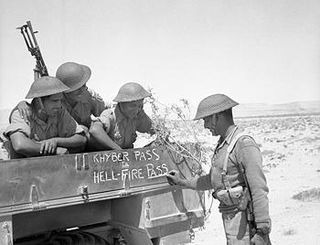 W
WOperation Battleaxe was a British Army offensive during the Second World War to raise the Siege of Tobruk and re-capture eastern Cyrenaica from German and Italian forces. It was the first time during the war that a significant German force fought on the defensive. The British lost over half of their tanks on the first day and only one of three attacks succeeded.
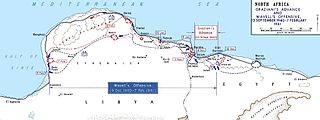 W
WThe rapid British advance during Operation Compass forced the Italian 10th Army to evacuate Cyrenaica, the eastern province of Libya. In late January, the British learned that the Italians were retreating along the Litoranea Balbo from Benghazi. The 7th Armoured Division was dispatched to intercept the remnants of the 10th Army by moving through the desert, south of the Jebel Akhdar via Msus and Antelat as the 6th Australian Division pursued the Italians along the coast road, north of the jebel. The terrain was hard going for the British tanks and Combeforce, a flying column of wheeled vehicles, was sent ahead across the chord of the jebel.
 W
WThe Battle of Bir Hakeim took place at Bir Hakeim, an oasis in the Libyan desert south and west of Tobruk, during the Battle of Gazala. The 1st Free French Brigade under Général de brigade Marie-Pierre Kœnig defended the position from 26 May – 11 June against much larger Axis forces of Panzerarmee Afrika commanded by Generaloberst Erwin Rommel. The Panzerarmee captured Tobruk ten days later.
 W
WOperation Brevity was a limited offensive conducted in mid-May 1941, during the Western Desert Campaign of the Second World War. Conceived by the commander-in-chief of the British Middle East Command, General Archibald Wavell, Brevity was intended to be a rapid blow against weak Axis front-line forces in the Sollum–Capuzzo–Bardia area of the border between Egypt and Libya. Although the operation got off to a promising start, throwing the Axis high command into confusion, most of its early gains were lost to local counter-attacks, and with German reinforcements being rushed to the front the operation was called off after one day.
 W
WOperation Caravan was a subsidiary of Operation Agreement under which four simultaneous raids were carried out against important Axis Lines of Communication positions in September 1942.
 W
WCastel Benito was an airport of Tripoli created by the Italians in Italian Libya. Originally, it was a small military airport, but it was enlarged in the late 1930s and was later used by the British RAF after 1943. It was called RAF Castel Benito by the Allies.
 W
WOperation Compass was the first large British military operation of the Western Desert Campaign (1940–1943) during the Second World War. British, Indian, Commonwealth and Allied forces attacked Italian forces of the 10th Army in western Egypt and Cyrenaica, the eastern province of Libya, from December 1940 to February 1941.
 W
WOperation Crusader was a military operation of the Western Desert Campaign during World War II by the British Eighth Army against the Axis forces in North Africa commanded by Generalleutnant Erwin Rommel. The operation was intended to bypass Axis defences on the Egyptian–Libyan frontier, to defeat the Axis armoured forces and to relieve the 1941 Siege of Tobruk.
 W
WThe Battle of El Agheila was a brief engagement of the Western Desert Campaign of the Second World War. It took place in December 1942 between Allied forces of the Eighth Army and the Axis forces of the German-Italian Panzer Army, during the long Axis withdrawal from El Alamein to Tunis. It ended with the German-Italian Panzer Army resuming its retreat towards Tunisia, where the Tunisia Campaign had begun with Operation Torch (8–16 November 1942).
 W
WOperation Flipper was a British commando raid during the Second World War, mainly by men from No. 11 (Scottish) Commando. The operation included an attack on the headquarters of Erwin Rommel, the commander of Panzergruppe Afrika in North Africa. It was timed for the night of 17/18 November 1941, just before the start of Operation Crusader. The operation failed as Rommel had left the target house weeks earlier and all but two of the commandos who landed were killed or captured. One member of the Special Boat Section team, who had secured the beach for the commando party, also escaped.
 W
WThe Battle of Gazala was fought during the Western Desert Campaign of the Second World War, west of the port of Tobruk in Libya, from 26 May to 21 June 1942. Axis troops of the Panzerarmee Afrika consisting of German and Italian units fought the British Eighth Army composed mainly of British Commonwealth, Indian and Free French troops.
 W
WThe Siege of Giarabub in Libya, was an engagement between Commonwealth and Italian forces, during the Western Desert Campaign of the Second World War. In the aftermath of Operazione E, the invasion of Egypt by the Italian 10th Army (9–16 September 1940), Operation Compass (9–16 December) by the Western Desert Force (WDF), the Battle of Sidi Barrani and the pursuit of the 10th Army into Cyrenaica (16 December 1940 – 9 February 1941) the fortified Italian position at the Al Jaghbub Oasis was besieged by parts of the 6th Australian Division.
 W
WConditions worsened for the Jews of Libya after the passage of Italy's Manifesto of Race in 1938. Following the German intervention in 1941, some of the Jews of Libya were sent to camps in continental Europe, where those who survived stayed until the end of World War II.
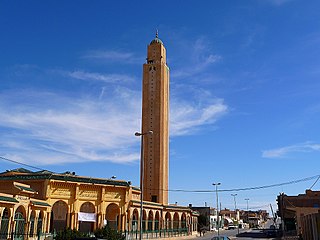 W
WJadu, in other languages also: Giado (Italian) and Gado, is a mountain town in western Libya, in the Jabal al Gharbi District and the Nafusa Mountains.
 W
WThe Capture of Kufra was part of the Allied Western Desert Campaign during the Second World War. Kufra is a basin and oasis group in the Kufra District of south-eastern Cyrenaica in the Libyan Desert. In 1940, it was part of the colony of Italian Libya Libia Italiana, which was part of Africa Settentrionale Italiana (ASI), which was established in 1934.
 W
WThe Maletti Group (Italian: Raggruppamento Maletti) was an ad hoc mechanised unit formed by the Italian Royal Army in Italian North Africa, during the initial stages of the Western Desert Campaign of the Second World War. The Italian army had three armoured divisions in Europe but all were needed for the occupation of Albania and the forthcoming invasion of Greece, which began on 28 October 1940. The Raggruppamento Maletti was formed in June 1940, as part of the 10th Army and contained all of the M11/39 medium tanks in Libya.
 W
WThe Battle of Mersa Matruh was fought from 26 to 29 June 1942, following the defeat of the Eighth Army at the Battle of Gazala and was part of the Western Desert Campaign of the Second World War. The combatant on the Axis side was the Panzer Army Afrika (Panzerarmee Afrika, consisting of German and Italian units. The Allied forces of the Eighth Army comprised X Corps and XIII Corps. The battle developed as the Afrika Korps pursued the Eighth Army as it retreated into Egypt. Rommel intended to engage and destroy the Allied infantry formations in detail, before the British had a chance to regroup. The Axis cut off the line of retreat of X Corps and XIII Corps but was too weak to stop the British from breaking out. The fortress port of Mersa Matruh and 6,000 prisoners were captured, along with a great deal of supplies and equipment but the Eighth Army survived.
 W
WMiddle East Command, later Middle East Land Forces, was a British Army Command established prior to the Second World War in Egypt. Its primary role was to command British land forces and co-ordinate with the relevant naval and air commands to defend British interests in the Middle East and eastern Mediterranean region.
 W
WThe North African campaign of the Second World War took place in North Africa from 10 June 1940 to 13 May 1943. It included campaigns fought in the Libyan and Egyptian deserts and in Morocco and Algeria, as well as Tunisia.
 W
WThe Battle of Point 175 was a military engagement of the Western Desert Campaign that took place during Operation Crusader from 29 November – 1 December 1941, during the Second World War. Point 175 is a small rise just south of the Trigh Capuzzo, a desert track east of Sidi Rezegh and south of Zaafran, with a good view of the vicinity. In early November 1941, the feature was held by German infantry of Division z.b.V. Afrika. Troops of the 2nd New Zealand Division and Infantry tanks of the 1st Army Tank Brigade attacked and captured Point 175 on 23 November, during the Battle of Sidi Rezegh, at the start of Operation Crusader. The New Zealand troops then attacked westwards and made contact with the Tobruk garrison, which had broken out to meet them. From 29 November – 1 December, the New Zealanders defended the point and the area to the west against Axis attempts to sever the link with the Tobruk garrison and regain control of the local roads. The new 132nd Armoured Division Ariete re-captured Point 175 late on 29 November.
 W
WSavari was the designation given to the regular Libyan cavalry regiments of the Italian colonial army in Tripolitania and Cyrenaica. The word "savari" was derived from a Persian term for "horsemen" (Savārān).
 W
WThe Senussi Cave Railway was a 400-yard long 2 ft (610 mm) narrow gauge railway, which was built in 1941 during the Siege of Tobruk at the Senussi Cave near Tobruk, Libya.
 W
WThe First Battle of Sirte was fought between the British Royal Navy and the Regia Marina during the Mediterranean campaign of the Second World War. The engagement took place on 17 December 1941, south-east of Malta, in the Gulf of Sirte. It was tactically inconclusive as both forces were limited by the strategic goal of protecting a convoy of their own and as such, neither were looking to force a full scale engagement.
 W
WThe Second Battle of Sirte was a naval engagement on 22 March 1942 in which the escorting warships of a British convoy to Malta held off a much more powerful Regia Marina squadron. The British convoy was composed of four merchant ships escorted by four light cruisers, one anti-aircraft cruiser, and 17 destroyers. The Italian force comprised a battleship, two heavy cruisers, one light cruiser, and ten destroyers. Despite the initial British success at warding off the Italian squadron, the Italian Fleet attack delayed the convoy's planned arrival before dawn, which exposed it to intense air attacks that sank all four merchant ships and one of the escorting destroyers in the following days. The battle occurred in the Mediterranean Sea, north of the Gulf of Sidra and southeast of Malta, during the Second World War.
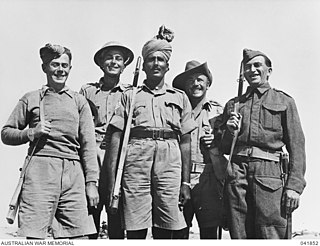 W
WThe siege of Tobruk lasted for 241 days in 1941, after Axis forces advanced through Cyrenaica from El Agheila in Operation Sonnenblume against Allied forces in Libya, during the Western Desert Campaign (1940–1943) of the Second World War. In late 1940, the Allies had defeated the Italian 10th Army during Operation Compass (9 December 1940 – 9 February 1941) and trapped the remnants at Beda Fomm. During early 1941, much of the Western Desert Force (WDF) was sent to the Greek and Syrian campaigns. As German troops and Italian reinforcements reached Libya, only a skeleton Allied force remained, short of equipment and supplies.
 W
WThe Axis capture of Tobruk, also known as the Fall of Tobruk and the Second Battle of Tobruk was part of the Western Desert Campaign in Libya during the Second World War. The battle was fought by Panzerarmee Afrika (Armata Corazzata Africa in Italian German–Italian military force in north Africa, which included the Afrika Korps and the British Eighth Army. The Eighth Army comprised contingents from Britain, India, South Africa and other Allied troops.
 W
WThe British capture of Tobruk was a battle fought between 21 and 22 January 1941, as part of Operation Compass, the first offensive of the Western Desert Force (WDF) in the Western Desert Campaign of the Second World War. After defeating the Italians in the Battle of Bardia, the 6th Australian Division and the 7th Armoured Division pressed on and made contact with the Italian garrison in Tobruk on 6 January.
 W
WThe Via della Vittoria was a military road between Bardia in Italian Libya and Sidi Barrani in western Egypt.
 W
WThe Battle of Wadi Akarit was an Allied attack from 6 to 7 April 1943, to dislodge Axis forces from positions along the Wadi Akarit in Tunisia during the Tunisia Campaign of the Second World War. The Gabès Gap, north of the towns of Gabès and El Hamma, is a passage between the sea and impassable salt marshes. The 51st (Highland) Infantry Division breached the defences and held a bridgehead, allowing the passage of their main force to roll up the Axis defences. After several determined counter-attacks, the Axis forces withdrew and the Eighth Army, under General Bernard Montgomery, pursued toward Tunis, until reaching Axis defensive positions at Enfidaville.
 W
WThe Western Desert campaign took place in the deserts of Egypt and Libya and was the main theatre in the North African campaign of the Second World War. Military operations began in June 1940 with the Italian declaration of war and the Italian invasion of Egypt from Libya in September. Operation Compass, a five-day British raid in December 1940, led to the destruction of the Italian 10th Army. Benito Mussolini sought help from Adolf Hitler, who sent a small German force to Tripoli under Directive 22. The Afrika Korps was formally under Italian command, as Italy was the main Axis power in the Mediterranean and North Africa.